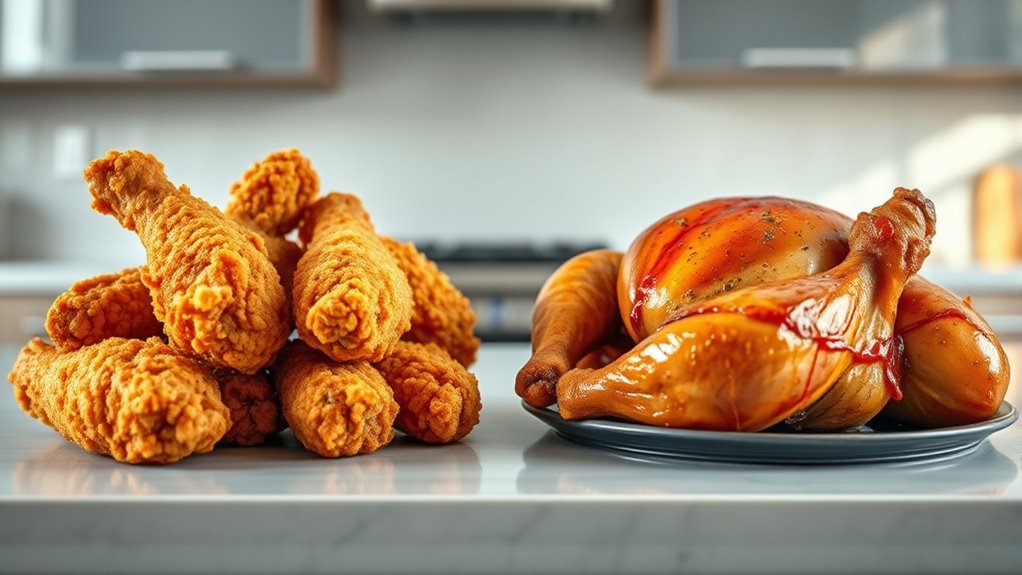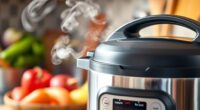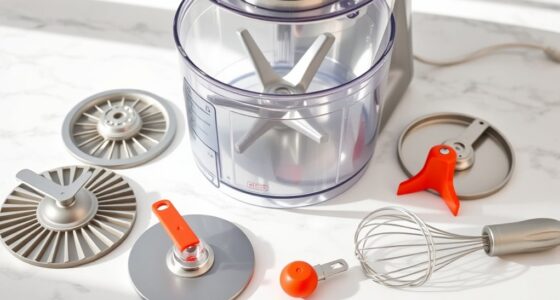The flavor and texture difference between air fryers and ovens come down to how they generate heat and circulate air. Air fryers use rapid hot air and high heat, creating a crispy exterior quickly, often with less oil. Ovens heat more evenly and gently, which preserves moisture and results in softer textures. Container size, material, and cooking settings also influence taste. To uncover more about these differences, keep exploring how each appliance affects your food.
Key Takeaways
- Air fryers use rapid air circulation and intense heat, creating a crispy texture and quicker browning compared to the more gradual heat of ovens.
- The high thermal conductivity of metal in air fryer baskets promotes faster heat transfer, influencing flavor development and texture.
- Ovens typically require more oil and gentler heat, resulting in different flavor profiles and moisture retention than the oil-efficient air fryers.
- Air fryers’ rapid, localized heating can cause uneven browning if ingredients aren’t evenly seasoned or arranged.
- The difference in airflow patterns and container sizes impacts heat distribution, leading to distinctive tastes between the two appliances.
How Air Fryers and Ovens Generate Heat

Both air fryers and ovens generate heat to cook food, but they do so in different ways. An oven heats through convection, radiation, and conduction, providing steady, consistent warmth that promotes even cooking. This method allows flavors to develop gradually, enhancing flavor infusion over time. In contrast, an air fryer uses rapid air circulation combined with a heating element to quickly cook food. This focused heat boosts cooking efficiency, reducing cooking time remarkably. The intense and localized heat in an air fryer can create a crispy exterior while sealing in flavors faster. Both appliances generate heat effectively, but their different methods influence how flavors develop and how quickly your food reaches perfection. Additionally, the way heat transfer occurs impacts the flavor profile and texture of your dishes.
Differences in Air Circulation and Its Impact on Food
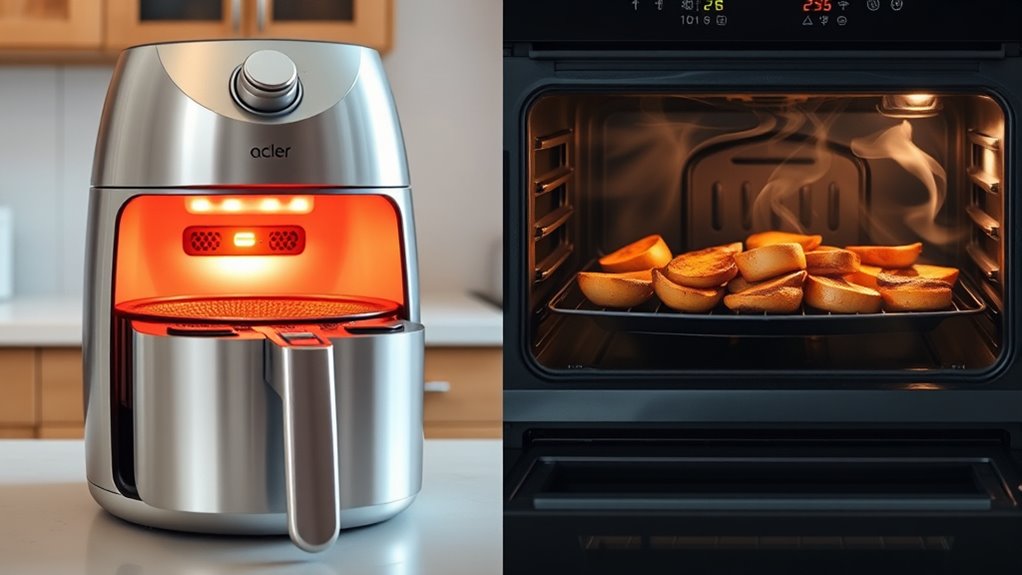
The way air circulates inside an air fryer differs considerably from that of an oven, and this has a direct impact on how your food cooks. In an air fryer, powerful fans create rapid airflow patterns that evenly distribute hot air around your food. This focused circulation results in a crispy exterior and faster cooking times. Ovens rely on oven vents to release moisture and heat, but their airflow patterns are less intense and more variable. The less consistent air movement means food may cook unevenly or take longer to crisp. Because of these differences, food cooked in an air fryer tends to be more uniformly crispy and browned, whereas oven-cooked dishes might have a different texture due to less direct air contact. Additionally, the air circulation in an air fryer can reduce cooking times, making it a more efficient option for quick meals.
The Role of Cooking Time and Temperature Settings
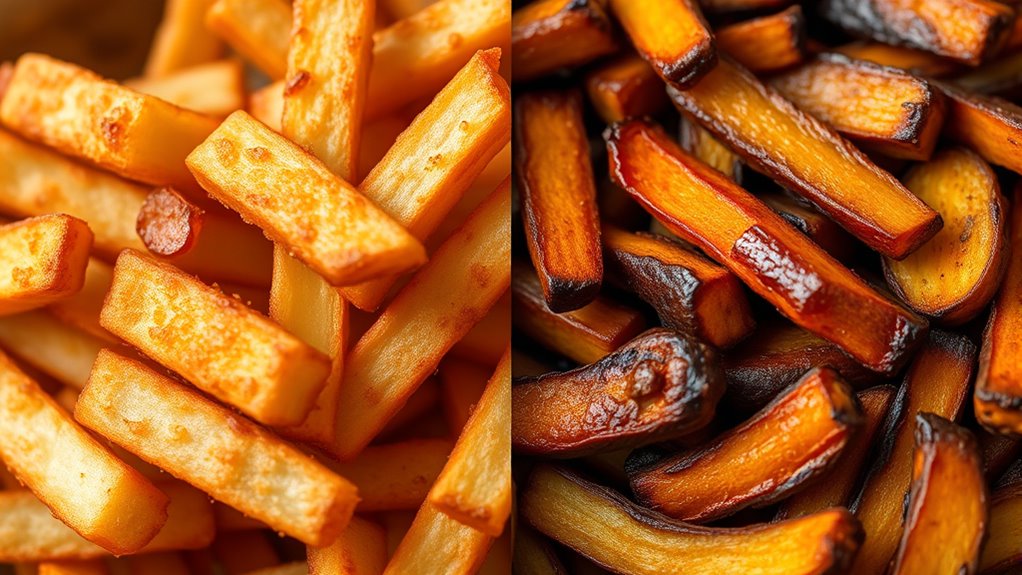
Cooking time and temperature settings play a crucial role in determining the final texture and doneness of your food. Setting the right parameters ensures you achieve ideal seasoning enhancements and appealing presentation aesthetics. When you adjust these settings, consider the following:
- Cooking duration affects crispiness and moisture retention, impacting flavor and appearance.
- Temperature control influences browning, which enhances taste and visual appeal.
- Overcooking can lead to dry, unappetizing results, diminishing presentation aesthetics.
- Undercooking may leave food under-seasoned and unappealing in texture.
- Properly calibrated cooking settings can also help preserve the nutritional value of your meals.
Effects of Oil Usage and Fat Content
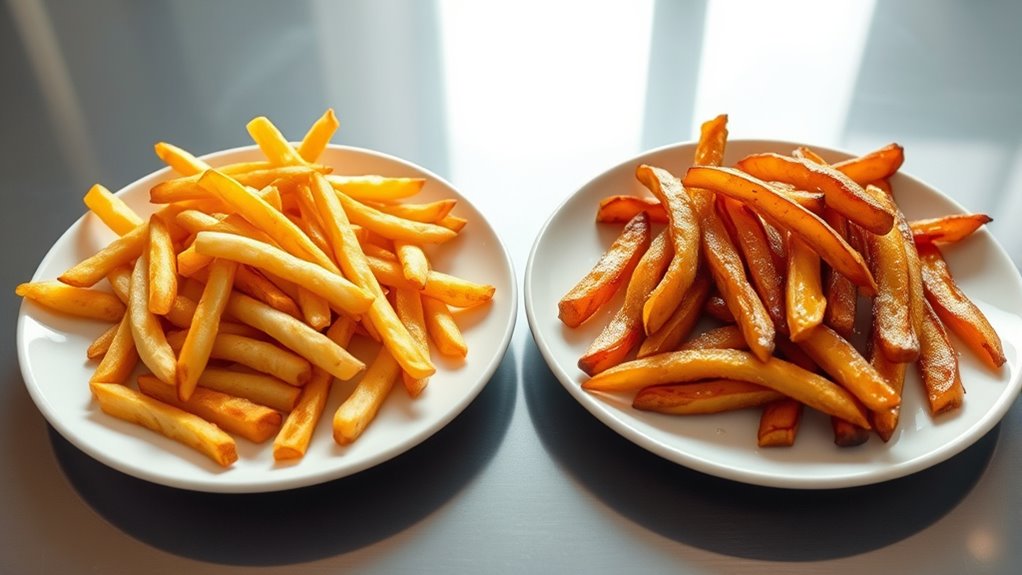
Using oil and controlling fat content considerably impact the healthfulness, flavor, and texture of your cooked food. In an air fryer, you typically use less oil, which reduces oil absorption and results in a lighter, crispier texture. This lower fat content can help you make healthier meals without sacrificing flavor. Conversely, traditional ovens often require more oil to achieve similar textures, leading to higher fat levels and potential concerns about calorie intake. By managing oil usage, you can enjoy crispy, delicious food with less fat, promoting better health and diet goals. Reducing fat not only affects calorie count but also influences how the food tastes and feels, making it vital to consider oil and fat management when choosing your cooking method. Additionally, understanding the types and features of cookware can help you select the best tools for achieving desired textures and flavors.
Variations in Maillard Reaction and Browning

Temperature differences between an air fryer and oven can markedly impact browning and the Maillard reaction. Airflow and moisture levels also influence how evenly food browns, with higher airflow promoting crispness. Additionally, surface contact plays a role, as direct contact enhances browning regardless of the appliance used. Furthermore, understanding the AI security vulnerabilities, such as bias and jailbreaking risks, can help consumers make more informed decisions about the safety and reliability of cooking-related AI kitchen devices.
Temperature Differences Matter
Since the temperature differences between an air fryer and an oven can considerably impact browning, understanding how these variations influence the Maillard reaction is essential. Higher temperatures promote more intense browning, but they also affect seasoning variations and ingredient freshness. When cooking in an air fryer, rapid heat transfers can cause quicker browning, sometimes leading to uneven results if ingredients aren’t fresh or evenly seasoned. Conversely, ovens tend to provide a gentler, more uniform heat, which can preserve ingredient quality and seasoning nuances. Consider these points:
- Higher temperatures accelerate Maillard reactions, affecting flavor development.
- Precise temperature control ensures consistent browning and texture.
- Ingredient freshness influences how well browning occurs at different temperatures.
- Seasoning variations become more pronounced with temperature shifts, impacting overall flavor.
- The calorific transfer process in air fryers differs from ovens, influencing the rate and evenness of browning.
Understanding these factors helps you get the perfect crust every time.
Airflow and Moisture Levels
Airflow and moisture levels play a crucial role in how effectively the Maillard reaction occurs during cooking. In an air fryer, the high airflow promotes rapid moisture evaporation, intensifying browning and enhancing flavor infusion. This quick evaporation leads to a crisp, golden exterior with a stronger culinary aroma. Conversely, traditional ovens often retain more moisture, which can slow the Maillard reaction, resulting in less intense browning. The drier environment in an air fryer helps food develop a more pronounced crust, amplifying taste and aroma. Maintaining ideal airflow and moisture balance is key to achieving the desired flavor profile and browning level, making your dishes more aromatic and flavorful. Adjusting these factors allows you to fine-tune the cooking process for better taste outcomes. Understanding food science can help optimize cooking techniques for superior flavor development.
Surface Contact and Browning
Surface contact directly influences how evenly and effectively the Maillard reaction occurs during cooking. When your food has better surface contact, it develops a more consistent surface texture and a desirable, crisp food crust. Poor contact can cause uneven browning, leading to patches that are undercooked or burnt. To optimize browning, consider these factors:
- Ensure your food is flat against the cooking surface for maximum contact.
- Use a preheated surface to jump-start the Maillard reaction.
- Avoid overcrowding, which can create steam and hinder crust formation.
- Adjust cooking time and temperature based on surface texture needs.
- Incorporate natural materials like wood or stone to improve heat transfer and enhance browning quality.
Influence of Cooking Environment and Container Materials

The materials of your cookware and container sizes play a big role in how evenly your food cooks. High heat conductivity materials like metal can speed up browning, while larger containers may affect air circulation. Understanding these factors helps you choose the right environment for consistent, delicious results. Additionally, performance tuning methods can be applied to optimize your cooking appliances for better heat management.
Material Heat Conductivity
Material heat conductivity considerably impacts how efficiently heat transfers during cooking, affecting both the air fryer and oven. Your choice of container material influences heat transfer efficiency, shaping how evenly food cooks. Higher thermal conductivity materials, like metals, transfer heat faster, leading to quicker cooking times and crispier textures. Conversely, insulators such as ceramics or glass slow heat transfer, resulting in more gradual cooking.
Consider these points:
- Material composition determines heat transfer speed.
- Metals like aluminum or copper excel in heat conductivity.
- Non-metals may require longer cooking times.
- Choosing the right material enhances cooking precision and flavor.
Understanding these factors helps you optimize your cooking environment for better taste and texture. Additionally, selecting materials with appropriate thermal properties ensures consistent results and prevents hot spots or uneven cooking.
Air Circulation Effects
Because the airflow within your air fryer or oven directly impacts how evenly food cooks, understanding how cooking environment and container materials influence air circulation is essential. Airflow patterns determine how heat moves around your food, affecting both cooking speed and consistency. In an air fryer, the compact size promotes rapid, focused airflow, leading to crispier results. Conversely, ovens typically have less concentrated airflow, which can cause uneven heat distribution. The materials of your containers also play a role; metal pans reflect heat efficiently, encouraging uniform airflow, while bulky or non-conductive containers can obstruct airflow, creating hot or cold spots. Recognizing these factors helps you optimize heat distribution and achieve more consistent, better-tasting results regardless of whether you’re using an air fryer or oven.
Container Size Impact
Choosing the right container size can considerably impact how evenly your food cooks in both air fryers and ovens. Container capacity and size limitations influence heat circulation and cooking efficiency. When your container is too small, food may overcrowd, preventing proper airflow and leading to uneven results. Conversely, a container that’s too large can hinder heat transfer, making cooking time longer.
Consider these points:
- Ensure the container fits comfortably without overcrowding.
- Use smaller containers for better heat circulation.
- Avoid oversized containers that reduce efficiency.
- Match container size with the appliance’s capacity for consistent results.
How Food Texture and Moisture Retention Affect Flavor
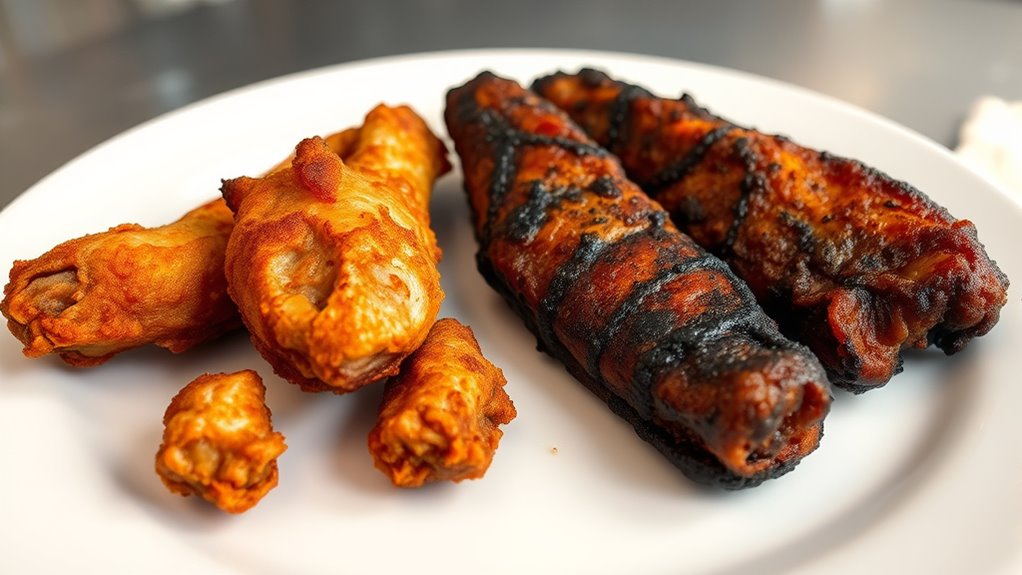
The way food’s texture and moisture retention influence flavor is essential when comparing air fryers and ovens. An oven’s slower, even heat helps keep food moist and tender, enhancing flavor and juiciness. Conversely, the rapid air circulation in an air fryer can create a crispy exterior but may dry out the inside if not managed properly. Proper seasoning techniques can compensate for moisture loss and boost flavor, especially in air-fried foods. Additionally, moisture retention impacts food presentation—juicier, well-textured dishes look more appealing. When cooking with an oven, you can better preserve the food’s natural moisture, resulting in more succulent bites. Understanding these differences helps you choose the right appliance for achieving your desired flavor and presentation.
Frequently Asked Questions
Can the Type of Food Influence Flavor Differences Between Air Fryer and Oven?
You might notice that the type of food influences flavor differences between an air fryer and oven. Certain foods, like crispy items, benefit from the air fryer’s rapid heat, enhancing food texture and seasoning retention. Conversely, wetter or delicate foods may not crisp as well in an air fryer, affecting flavor. So, your choice depends on how you want the texture and seasoning to turn out, making each appliance better suited for different dishes.
How Does Preheating Time Affect Food Taste in Both Appliances?
Preheat duration impacts your food’s taste by ensuring consistent cooking temperature. If you preheat too briefly, your food may cook unevenly, affecting flavor and texture. Conversely, a longer preheat time promotes better cooking consistency, resulting in more balanced flavors. Both air fryers and ovens benefit from proper preheating, helping you achieve crispy, flavorful results and avoiding sogginess or undercooking. Always give your appliance enough time to fully preheat.
Do Different Brands of Air Fryers and Ovens Alter Flavor Outcomes?
Brand variations in air fryers and ovens can definitely impact flavor outcomes. Different brands use varying heating elements, cooking surfaces, and airflow systems, which influence how evenly food cooks and how flavors develop. You might notice that some brands produce crisper textures or richer tastes due to these differences. So, when choosing appliances, consider brand reputation and how their unique features, especially cooking surfaces, can affect your food’s flavor.
What Impact Does Altitude Have on Cooking Results and Flavor?
Did you know that at high altitudes, boiling water drops to 198°F instead of 212°F? This illustrates how altitude effects can alter cooking times and flavors. When you cook at high elevations, ingredients may cook unevenly, affecting flavor consistency. You might notice your dishes taste different or lose some richness. Adjusting cooking times and techniques helps maintain flavor, but altitude effects remain a key factor in achieving perfect results.
How Do Cleaning and Maintenance Routines Affect Food Taste Over Time?
Cleaning routines and maintenance schedules play a vital role in ensuring your appliances perform well over time. When you regularly clean and maintain your equipment, it prevents buildup of grease, grime, and food residue that can alter flavors. If you neglect these routines, flavors can become stale or off-taste. So, staying consistent with cleaning routines and adherence to maintenance schedules keeps your food tasting fresh and delicious every time.
Conclusion
As you savor your crispy fries or golden chicken, remember it’s the dance of heat, air, and time that shapes their flavor. The air fryer’s rapid whirl and oven’s steady warmth each craft a unique symphony of browning and moisture. So, next time food tastes a little different, embrace the journey—trust how these subtle differences turn simple ingredients into a delightful, sensory experience that lingers on your palate.
